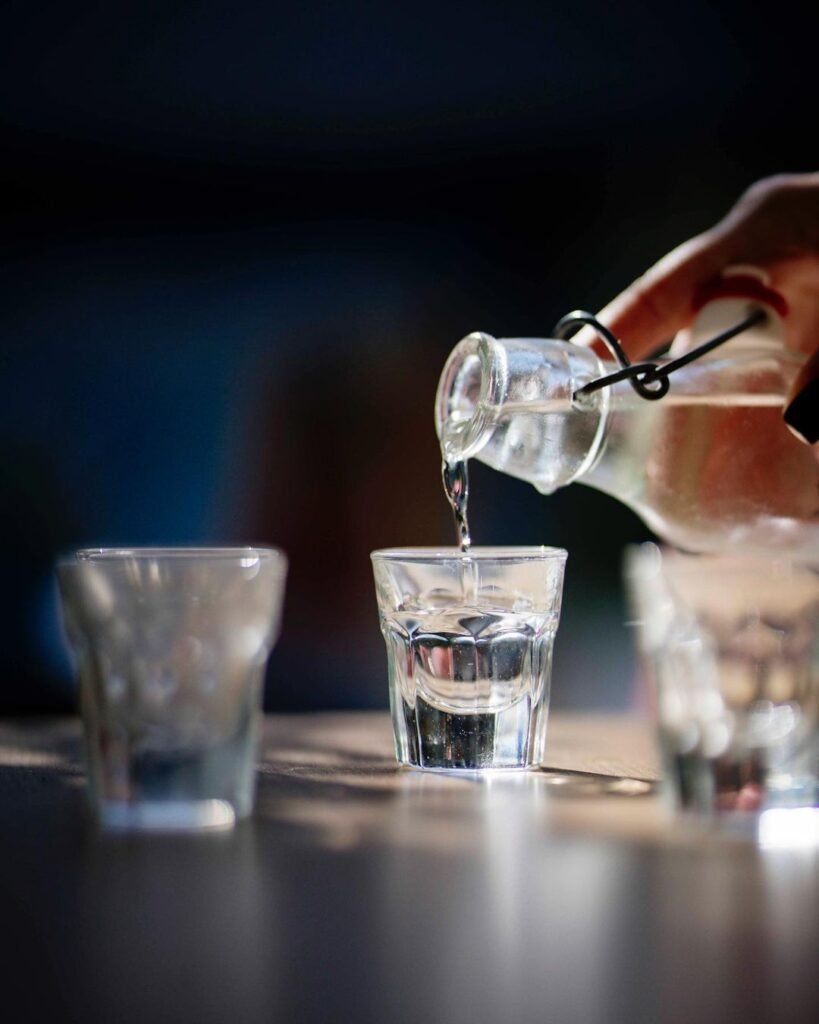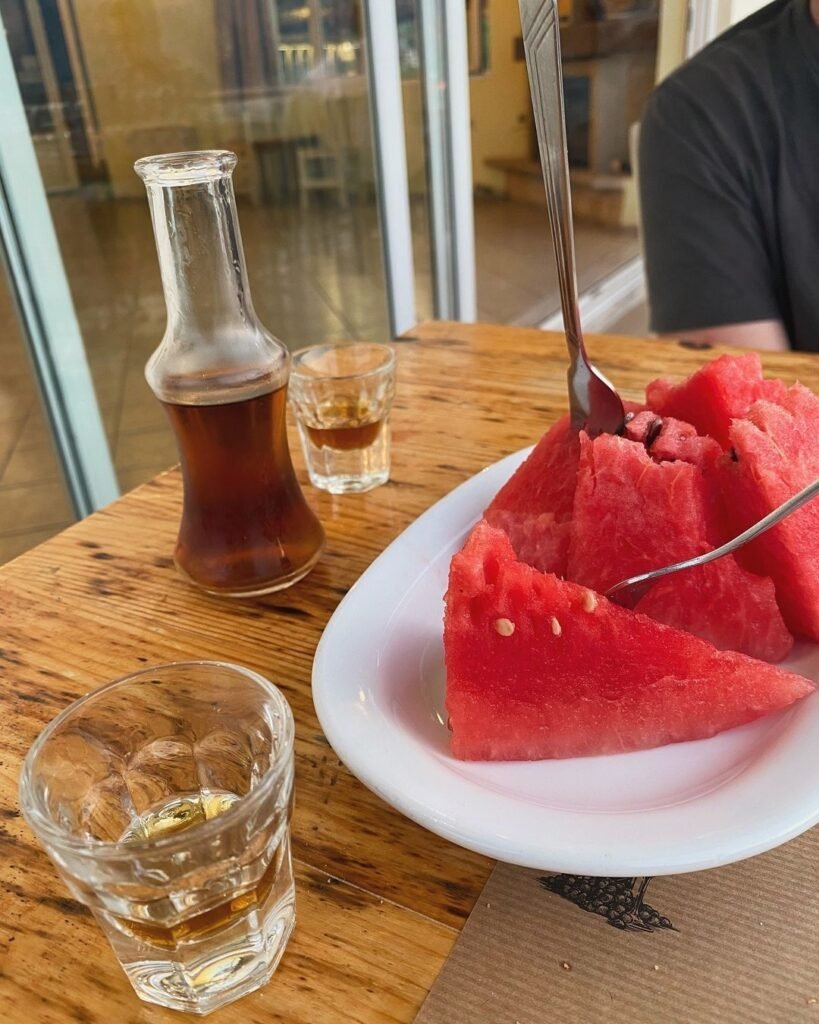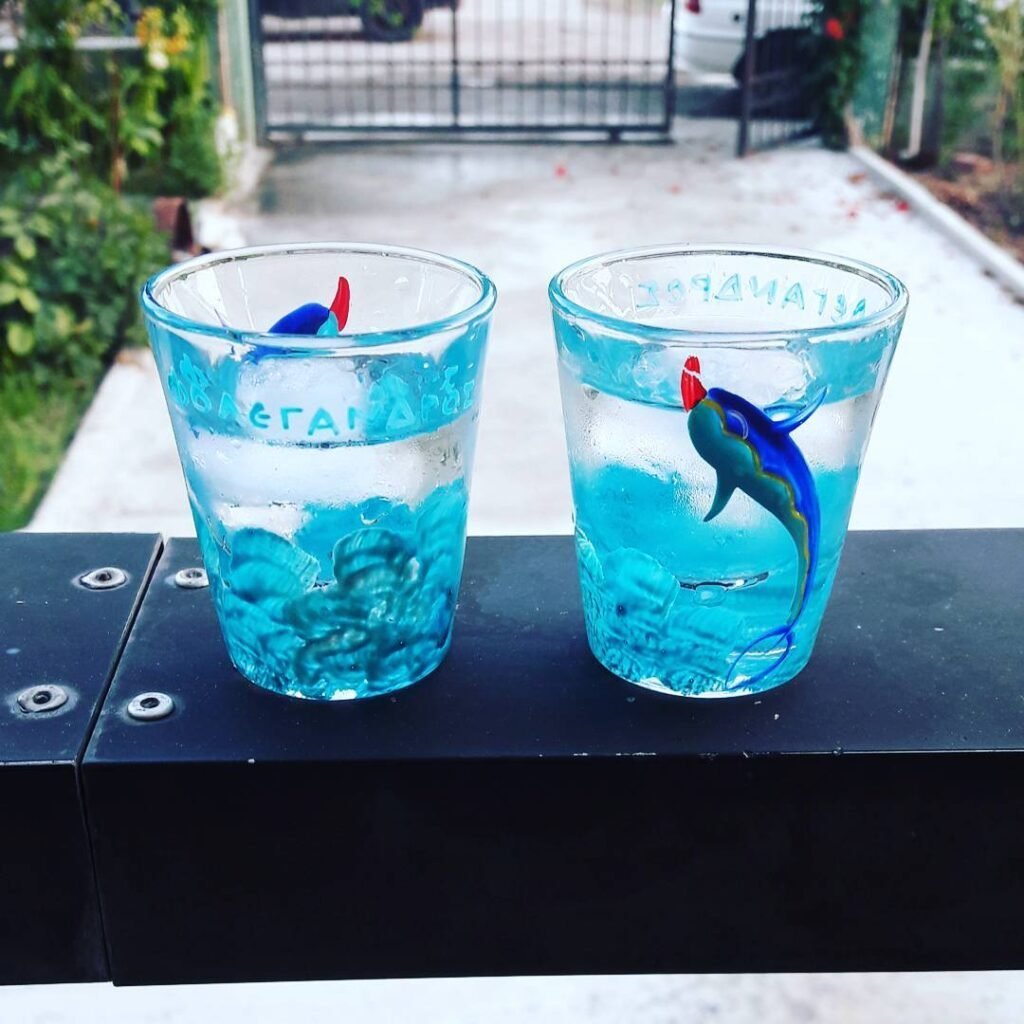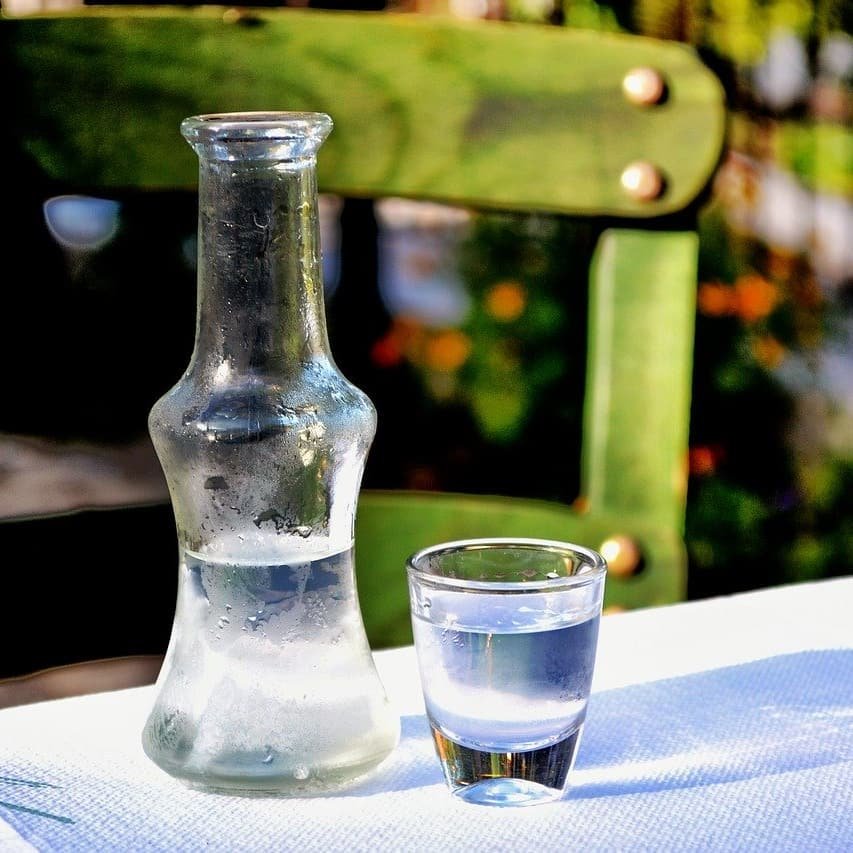As you commence your journey into the world of Cretan Raki, also known as Tsikoudia, you’ll quickly discover that this ancient spirit is far more than just another drink. It’s a portal to understanding Cretan culture, history, and hospitality. From its unique production process to its integral role in social gatherings, Raki holds secrets that every enthusiast should uncover.
Whether you’re a seasoned spirits connoisseur or a frequent visitor to Crete who’s enjoyed complimentary Raki after countless meals, there’s still much to learn about this engaging elixir.
Let’s dive into the essential aspects of Cretan Raki that will deepen your appreciation for this iconic Greek spirit.
What Is Cretan Raki/Tsikoudia?
At the heart of Cretan culture lies a spirit as potent as it’s revered: Cretan Raki. This clear, fiery elixir, also known as Tsikoudia, has flowed through the veins of Cretan society for centuries, its origins stretching back to the ancient Minoan civilization. As you sip this potent brandy, you’re tasting the very essence of Cretan heritage, distilled into a glass.

Unlike its Turkish namesake, which shares more in common with Greek ouzo, Cretan Raki is born from the humble pomace – the solid remnants of grapes after winemaking. This unique production process, perfected over generations, has earned Tsikoudia from Crete a coveted EU geographical indication since 2016. It’s a commemoration to the spirit’s deep-rooted connection to the island’s terroir and traditions.
This crystal-clear spirit, with an alcohol content ranging from 40% to 65%, is typically served chilled as a digestif. Its aroma hints at its grape origins, with a slightly sweet scent that belies its potent nature. In many parts of Crete, families still produce their own Raki, continuing a tradition that’s as much a part of the island’s culture as its ancient ruins and stunning beaches.

When you’re offered a glass of Raki by a local Cretan, know that you’re being extended more than just a drink. You’re being invited into the heart of Cretan hospitality, a gesture of acceptance and respect that transcends language barriers. It’s an opportunity to experience the true spirit of Crete, one sip at a time.
Tsikoudia vs Other Spirits: Understanding the Differences
First, let’s clear up any confusion with Turkish Raki. Despite sharing a name, these two are as different as the Aegean is from the Black Sea.

While Turkish Raki is anise-flavored and turns milky when mixed with water (much like ouzo), our Cretan hero remains crystal clear, unadulterated by any additional flavorings.
This clarity sets Tsikoudia apart from other famous Greek spirits as well. Take ouzo, for instance. Where ouzo’s distinct licorice notes come from added star anise, Tsikoudia’s flavor is purely grape-derived, offering a more direct connection to Crete’s sun-soaked vineyards.
Now, you might be wondering about Tsipouro, another Greek grape-based spirit. While they’re close cousins, with similar production methods, Tsikoudia is exclusively Cretan, embodying the island’s terroir and traditions. Tsipouro, on the other hand, is produced throughout mainland Greece and may sometimes contain anise.

What truly sets Tsikoudia apart is its unadulterated purity. Unlike many spirits that add flavorings or undergo multiple distillations, Tsikoudia is typically distilled only once, preserving the essence of the Cretan grape in every sip. It’s this simplicity and connection to the land that has earned it playful nicknames like “Cretan Jet Fuel” or the “Fire Spirit of the Mediterranean.” And if you’ve ever had the pleasure of sipping Raki in Crete, you’ll understand immediately why it’s earned these fiery monikers!
The Production Process of Tsikoudia
Delving into the production process of Cretan Raki reveals a meticulous journey from grape to glass. As the crisp autumn air settles over Crete’s sun-drenched vineyards, the grape harvest commences, marking the beginning of this time-honored tradition.

Once harvested, the pomace—a mixture of grape skins, seeds, and stems—is left to ferment in barrels for six weeks. Imagine the heady aroma wafting through the air as the mixture is stirred regularly, coaxing out the essence of the grapes.
Then comes the magical transformation: distillation in the Kazani, a special kettle that’s been used for generations. For three hours, the fermented pomace slowly releases its spirit, guided by the watchful eye and experienced hand of the distiller. You can almost feel the warmth of the Kazani and hear the gentle bubbling as the tsikoudia takes form.

The result? A crystal-clear elixir, typically 20 degrees Celsius, that captures the very soul of Cretan tradition in every drop.

But there’s even more to the story of Raki production.
The grapes used are typically local Cretan varieties, such as Vidiano, Kotsifali, or Mandilari. The process begins in late October or early November, after the wine harvest, when the leftover grape pomace is at its freshest.
While many families and small producers still use traditional methods passed down through generations, some larger operations have incorporated modern techniques to increase efficiency. However, the core process remains the same, relying heavily on the distiller’s expertise.

The distiller, often a respected figure in the community, must carefully monitor the Kazani‘s temperature and the flow of the distillate. Their expertise ensures that only the ‘heart’ of the distillation – the purest, highest-quality portion – is collected for consumption.
The Kazani itself is a fascinating piece of equipment, steeped in tradition. Typically made of copper, these stills come in various sizes, from small family-owned versions to larger commercial units. The copper construction isn’t just for show – it plays a crucial role in the distillation process by removing sulfur compounds and enhancing the spirit’s purity.

Many Kazania bear the marks of generations of use, with dents and patinas telling the story of countless distillations. In some villages, a single Kazani might be shared among several families, turning the distillation process into a communal event that strengthens local bonds.
It’s worth noting that while many Cretans produce tsikoudia for personal consumption, commercial production is regulated to maintain the spirit’s traditional character and quality.

Tasting Notes and Characteristics of Cretan Raki
The first sip of Cretan Raki is an adventure for your senses. As the clear, potent spirit touches your lips, you’ll be greeted by an intense burst of flavor that’s uniquely Cretan. The initial taste is bold and grape-forward, a testament to the island’s sun-kissed vineyards and age-old distillation methods. You’ll notice hints of fruit dancing on your palate, a subtle sweetness that balances the spirit’s fiery nature.

As the warmth spreads through your chest, you’ll understand why Cretans cherish this drink. With an alcohol content ranging from 40% to 65%, Tsikoudia isn’t for the faint of heart. Yet, its complexity invites you to savor each sip slowly, allowing the flavors to unfold. Remember, Raki is meant to be sipped, not shot – taking your time allows you to fully appreciate its nuanced character.
The single distillation process preserves the essence of Cretan terroir, offering a pure, unadulterated representation of the island’s spirit. As you swirl the crystal-clear liquid in your glass, you’ll be struck by its simplicity and depth. This is more than just a drink; it’s a journey through Cretan culture, bottled and shared with pride.

What makes Cretan Raki truly fascinating is its variability.
As you travel from taverna to taverna across Crete, you’ll notice subtle differences in each establishment’s offering. These variations are a testament to the artisanal nature of Tsikoudia production, with each distiller imparting their own unique touch to the process. Some might be slightly sweeter, others more robust – each glass tells the story of its maker and the land it comes from.
While traditional Tsikoudia is a pure expression of the grape, innovative producers have begun experimenting with flavored varieties. You might encounter Raki infused with honey, herbs, or fruits. A particularly delightful variation, and my personal favorite, is rodoraki, a pomegranate-flavored tsikoudia that adds a fruity twist to the traditional spirit.

Other popular flavors include lemon, strawberry, and caramel, each offering its own unique character. However, it’s rakomelo – Raki infused with honey – that has captured the hearts of many Cretan Raki enthusiasts. These flavored versions offer a new dimension to the Raki experience, while still honoring the essence of this beloved Cretan tradition.
Cultural Significance
From the sun-drenched hills to the bustling tavernas, Tsikoudia flows through the veins of Cretan culture. This potent spirit isn’t just a drink; it’s a symbol of hospitality, friendship, and tradition that permeates every aspect of island life.

As you journey through Crete, you’ll quickly discover that Cretan Raki is omnipresent. It graces tables at almost every occasion, from casual gatherings to grand celebrations. But it’s the ritual of offering Raki that truly captures its cultural essence. When you ask for the bill at a taverna, don’t be surprised if the waiter returns with a bottle of Raki, often accompanied by a plate of fresh fruit or a homemade dessert – all on the house. This gesture isn’t just about free drinks; it’s the Cretan way of saying “Take your time, enjoy, and let’s savor this moment together.”

This tradition extends beyond restaurants. Don’t be shocked if you find yourself offered a glass of Cretan Raki in the most unexpected places – from souvenir shops to local businesses. It’s not uncommon to see a shopkeeper produce a bottle of Raki when a friendly conversation strikes up, turning a simple transaction into a warm cultural exchange.
The pinnacle of Raki’s cultural significance is perhaps best witnessed during the Rakokazana, a festive event that brings entire communities together. Picture yourself amidst the joyous chaos: the air thick with the aroma of distilling grapes, traditional music filling your ears, and platters of mouthwatering local delicacies tempting your taste buds. It’s here, in the heart of Cretan merriment, that you’ll truly understand the social phenomenon of Tsikoudia.
Cretans have their own endearing ways of referring to Raki, especially when serving it to guests. You might hear it playfully offered as “some vitamins for your health” or called “the spirit that brings spirits up.” These affectionate nicknames reflect the warmth and humor that accompany the sharing of Tsikoudia.
But the real treasure lies in those moments when a local Cretan invites you to share a glass. This simple act transcends mere consumption; it’s an honor, a gesture of acceptance that opens the door to authentic Cretan culture. As you raise your glass in the time-honored toast of “Yamas!” (to our health), you’re not just drinking Tsikoudia – you’re imbibing the very essence of Cretan philoxenia, their legendary hospitality that turns strangers into friends.

How to Drink Cretan Raki
Now that you’ve grasped Raki’s cultural significance, let’s explore how to enjoy this spirited elixir properly. The key to appreciating Cretan Raki lies in the art of slow sipping, not shooting it back like a college student at happy hour. This isn’t just about savoring the flavor—it’s about embracing the Cretan way of life.

Serve your Raki chilled, straight from the refrigerator, to enhance its crisp, invigorating qualities. As you pour the clear liquid into the traditional narrow glass, known as a “rakopotiro,” you’ll feel a connection to centuries of Cretan tradition. The glass’s design allows for controlled sips, enabling you to savor the full flavor profile of this potent spirit.
Now, here’s the most important part: despite its appearance in a small glass, Cretan Raki is emphatically not meant to be taken as a shot. This is a common mistake made by enthusiastic tourists (and we’ve all been there!), but it’s a faux pas that might earn you a gentle correction from a local. Instead, treat Tsikoudia as you would a fine whiskey or cognac – it’s meant to be sipped slowly, allowing you to appreciate its complex flavors and aroma.

Take your time with each sip. Notice how the initial fiery sensation gives way to subtle grape notes and a surprisingly smooth finish. Remember, there’s no rush—Cretans see Tsikoudia as a companion to conversation and relaxation, not a means to quick intoxication.
To truly immerse yourself in the Cretan experience, pair your Tsikoudia with an array of meze. Picture yourself on a sun-drenched terrace overlooking the azure Mediterranean. Before you is a spread of local delicacies: briny olives, creamy local cheese, tzatziki, crusty bread, and roasted vegetables. Perhaps there’s some octopus drizzled with olive oil, or dolmades stuffed with herbs and rice. The combination of flavors will dance on your palate, perfectly complementing the Raki’s intensity.

For a refreshing twist, try accompanying your Raki with fresh fruits like grapes, melons, or citrus. Their natural sweetness provides a delightful balance to the spirit’s robustness. Some locals swear by pairing Raki with watermelon on a hot summer’s day—a combination that’s both refreshing and quintessentially Cretan.
As you enjoy your Raki, remember that it’s not about the quantity, but the quality of the experience. When you’re offered a bottle at a taverna, there’s no obligation to finish it all. Instead, use it as an opportunity to linger, chat, and soak in the Cretan atmosphere.

Traditional Remedies and Health Considerations
In Crete, Tsikoudia isn’t just a beloved spirit—it’s also revered for its potential health benefits and medicinal uses. Passed down through generations, these traditional remedies showcase the versatility of this potent elixir in Cretan folk medicine.
One of the most popular medicinal uses of Cretan Raki is in creating herbal tinctures. Cretans infuse Raki with various herbs to harness their therapeutic properties. For instance, olive leaf tincture, made by steeping ground olive leaves in Tsikoudia for 4-6 weeks and then straining the mixture, is believed to help manage blood sugar levels in Type 2 diabetes.

Another common infusion is echinacea flowers in Cretan Raki. This tincture is used when feeling under the weather, as echinacea is known for its immune-boosting properties. Research suggests it may help reduce the duration and severity of cold and flu symptoms.
Rakomelo, a warm mixture of Raki and honey, is a Cretan favorite for soothing sore throats and easing congestion. The antiseptic properties of Raki combined with the soothing effects of honey make this a go-to remedy during cold and flu season.
Topically, Tsikoudia finds numerous applications in Cretan households:
- It’s rubbed on the chest, back, and soles of the feet to help break a fever.
- Used as a massage oil for alleviating muscle aches and joint pain.
- Applied to insect bites to reduce itching and inflammation.
- Utilized as an antiseptic for cleaning minor wounds due to its high alcohol content.

Some Cretans believe that moderate consumption of Tsikoudia can improve blood circulation, thanks to its potential vasodilating effects. However, it’s crucial to remember that while these traditional uses are deeply ingrained in Cretan culture, scientific evidence supporting these applications is limited. That said, there’s often wisdom in generations of lived experience; sometimes, the word-of-mouth knowledge passed down through decades can be just as valuable as modern studies.
As with any alcoholic beverage, moderation is key. Excessive consumption of Cretan Raki can lead to serious health issues, including liver damage and increased risk of certain cancers. It’s always best to consult with a healthcare professional before using Raki or any alcohol for medicinal purposes.

Buying and Storing Cretan Raki
Having savored the cultural significance of Cretan Raki, you’ll want to know where to find this authentic spirit and how to keep it at its best. To experience the true essence of Cretan Raki, seek out products bearing the protected geographical indication from Crete. These bottles carry the island’s legacy, each sip transporting you to sun-drenched vineyards and age-old distilleries.
As you browse, let your eyes linger on the raki’s clarity. Quality tsikoudia should be as transparent as the Aegean waters lapping Crete’s shores, free from any sediment or cloudiness. Imagine holding a bottle up to the light, watching it sparkle like liquid diamonds.

For the most authentic experience, consider undertaking a pilgrimage to Crete itself. There, you’ll find small, family-owned distilleries nestled in picturesque villages, where you can taste and purchase tsikoudia directly from the artisans who craft it. Don’t be surprised if you’re offered a glass (or two) during your visit – it’s all part of the Cretan hospitality!
Once you’ve secured your treasure, store it in a cool, dark place, away from sunlight’s fervent fingers. Unlike wine, raki doesn’t improve with age, but its high alcohol content helps preserve it. An unopened bottle can last indefinitely, while an opened bottle, if stored properly, can maintain its quality for several years. However, for the best flavor experience, it’s recommended to enjoy it within a year or two of opening.

Remember, while commercial brands are widely available, many Cretans prefer homemade raki. If a local offers you some of their personal stock, consider it a special honor – these small-batch, homemade versions often carry unique flavors that reflect the maker’s personal touch.

Conclusion
As you’ve journeyed through the world of Cretan Raki, you’ve uncovered its essence, from production to cultural significance. You’re now equipped to appreciate this timeless spirit, whether sipped slowly or shared with friends. Remember, Tsikoudia isn’t just a drink; it’s a gateway to Crete’s heart and soul. So next time you raise a glass, you’ll taste not just the grape, but centuries of tradition. Let Raki be your passport to the warmth and hospitality of Cretan culture. Yamas!

